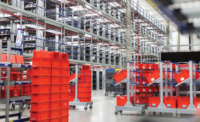Many snack producers and bakery companies outsource their logistics and distribution needs, which is where third-party logistics (3PL) comes in to play. These third-party companies coordinate best routes, handling multiple deliveries to one customer in one day, order tracking, quality control and more.
The benefits of 3PL
Compared to handling tasks internally, there are many benefits for food companies to select a 3PL company to handle warehousing and/or delivery.
“Forward-thinking 3PLs with recognized thought leaders are able to provide top-caliber technology solutions that help food companies comply with key government and industry regulations, capacity issues and rising operational costs,” says Rick Zaffarano, vice president, consumer products solutions, Transportation Insight, Hickory, NC.
Transportation Insight’s blended technology platform allows clients the level of visibility required to monitor the life cycle of products, track products for food-safety purposes, and identify supply-chain opportunities to increase efficiencies and to improve speed to market, notes Zaffarano.
A major reason to opt for 3PL is the degree of specialization such companies bring to the table. “The latest generation of delivery/transportation companies typically will have access to a far better-connected, more-flexible and more-scalable resource base than in-house transportation services,” remarks Simon Bunegar, senior vice president, marketing, CX North America, Tecumseh, Ontario. “While there are many benefits associated with 3PL use, one of the most important is the ability to increase capacity on-demand in the right place at the right time.”
The main benefits of 3PL are expanded resources and economies of scale, notes Randy Gabardi, vice president, operations, Johanson Transportation Service (JTS), Fresno, CA. “By partnering with a 3PL, a food company gains access to an entire network of resources dedicated strictly to the safe transportation of goods. This allows the food company to concentrate on its core strengths, while taking advantage of the transportation purchasing power and expertise of the 3PL.”
A 3PL can especially help food companies, which are often burdened with many expectations and regulations.
“The simple task of creating and maintaining contracts with an adequate network of service providers would consume far more time than it would be worth for most companies,” says Andrew Lynch, president, Zipline Logistics, Columbus, OH. “Specific to food companies, there are myriad equipment requirements, food safety regulations and—in the case of anyone with a retail end-user—an array of customer expectations and communication protocols that need to be managed. A 3PL, especially a specialized 3PL, can manage this to a much greater proficiency and cost effectiveness.”
Managing challenges
The snack and bakery market has many challenges when it comes to delivering a fresh, on-time product.
“The food industry is affected by numerous government and food-safety regulations that threaten to slow source-to-shelf time,” says Zaffarano. “Other growing challenges—such as finding shipping capacity to meet demand, tighter delivery time windows and more frequent deliveries—all create opportunities to negatively impact the customer experience.”
To make sure that customers remain happy, communication and collaboration are key. “Fresh baked goods comprise a time-sensitive product line—communication, and flexibility to deal with unforeseen contingencies, is vital. Trucks cannot be sitting on the road as products degrade, or miss delivery windows that can be as short as 15 minutes. Being able to act in real time is essential,” says Bunegar. “The top challenges are communication and collaboration across multiple companies.”
Multiple categories of baked goods require temperature control during distribution, something select 3PL companies can effectively manage. “Quality is a top priority for food and beverage companies, since they need to meet local and international regulations, and comply with the highest standards, since final products are for consumption,” states Bill Heaney, vice president/head of consumer and retail sectors, DHL Global Forwarding, Americas, Miami. “The top challenges are related to keeping goods at the same temperature across the supply chain.”
DHL’s Thermonet/LifeConEx trackers ensure quality of goods. “Our customers are not only concerned with temperature, but also keeping certain humidity levels,” continues Heaney.
“The logistics of perishable products can be a daunting task for any shipper,” says Gabardi. “There are specific timelines to meet, food-quality regulations to be strictly enforced, seal policies to be followed, strict temperature requirements, and documentation to be recorded.” He notes that JTS is an expert in perishable logistics, including bakery. “A 3PL will increase on-time deliveries, create efficiencies in the transportation process, and increase your customer service levels—adding dollars to your bottom line.”
New regulations
New Food Safety Modernization Act (FSMA) requirements related to safe transport go into effect in April, and 3PL companies are poised to meet the new challenges.
“With new FSMA handling requirements going into effect, temperature-controlled vehicles may have longer dwell times,” says Lynch. “Smaller carriers are less likely to have current-generation equipment that offers built-in telematics, and will have to either invest in third-party systems like SkyBitz, new trailers, or take extra steps to obtain temperature records from Carrier or Thermo King. The key to this will be in ensuring that your 3PL of choice can build out organization-wide processes that solve for this exposure.”
The Hours of Service, FSMA, electronic logging device (ELD) requirements and others continue to be a top concerns for cost-conscious shippers, says Zaffarano. “Keeping track of these regulations is a full-time job.”
Transportation Insight’s solution to this is to offer a suite of services that can help deliver key visibility to product movements from source to customers, to help clients better mitigate risk created by many of the new regulations.
“A growing trend is for manufacturers, distributors and retailers to align their companies with a 3PL that can evaluate the entire supply chain, identify areas for improvement and co-execute a supply-chain management strategy,” says Zaffarano.
“FDA regulations push the supply chain—always—to find shorter transit times, since different raw materials are perishables,” remarks Heaney.
“The FSMA rule creates specific requirements for shippers, loaders, motor carriers, rail carriers and receivers who are involved in the transportation of food that is subject to the rule,” says Gabardi. The challenge, he notes, remains finding highly qualified carriers that meet the regulatory demands, as well as the need of food shippers.
Looking to the cloud
3PL is constantly changing, with cloud computing and mobile/wireless technology among the forefront of recent advances.
Increasingly, a 3PL’s transportation management systems (TMS) is in the cloud. “JTS’s current generation cloud-based TMS, FreightOptixx, allows all members of the supply chain to have access to the full breadth of shipping data. This allows for 24/7 connectivity to the information they need, when they need it. Technology also provides GPS tracking chips and temperature-monitoring devices to allow for full control of food product safety,” says Craig Johannson, vice president, logistics, JTS.
“Cloud computing is becoming the norm within supply-chain management, because it allows companies to deploy transportation management solutions quickly, easily and for less cost,” explains Zaffarano. “Supply-chain technology has evolved to enable faster, more-robust analytics that allow organizations to forecast what might happen in the future, based on collected data.”
Transportation Insight applies predictive, strategic planning powered by a continuous improvement mindset grounded in LEAN methodology and a blended technology platform. This approach brings companies a customized platform that can drive meaningful increases in enterprise value.
“Integrating these new technologies into the supply chain leads to tactical advantage and reduces costs, while improving efficiency and productivity,” adds Zaffarano.
“Telematics and mobile connectivity allow 3PLs to know, at all times, where every piece of their logistics network is—vehicles, drivers, trailers, etc.—and understand how that information relates to traffic conditions on the road and at pickup and delivery points,” says Bunegar. “And, it allows them to do so in the most lean and efficient way.”
Bunegar notes cloud and mobile solutions deliver the right functionality to every point within the logistics network, in the most cost-effective and efficient manner possible. “Rather than having to build a web of server-heavy systems in company after company, mobile/wireless technology offers a less capital-intensive solution without the major integration requirements needed to be interoperable,” he says.
“Tools have advanced—both hardware and software—to the point where people with the right supply-chain expertise can really take advantage of the information through more efficient management of the vast volume and speeds in which data is created,” says Zaffarano.
Unique services and capabilities
Many 3PLs bring a diverse range of capabilities and efficiencies to the table.
JTS’s Carrier Relations team verifies operating authority and carrier insurance, checks safety ratings and references, and tracks fraudulent activities in the marketplace on a daily basis, says Johannson.
Transportation Insight uses Insight TMS, a web-based system that drives operational process efficiencies, cost reduction, and improved visibility and responsiveness across the entire supply chain. Insight TMS allows customers to know where each shipment is, so that they can plan accordingly and maintain smooth operations.
“Transportation Insight provides continuous analysis to ensure the client can best meet customer demand at the least landed costs,” says Zaffarano. “Our supply-chain reporting and analytics enable companies to better understand and allocate logistics costs.”
DHL offers its customers a few key capabilities, including same-day delivery, ocean and air freight, and more. “We offer services for immediate air freight,” says Heaney, 24/7, 365 days a year. “We also offer a CO2 report to help customers support their global environmental requirements.”
CX North America’s solutions allow companies to access and employ the expertise of other transport companies, whether on a schedule, contract or ad-hoc basis, in a way that furthers the business goals of both firms. “The CX North America solution is all about enabling collaboration across the transportation sector,” Bunegar adds. “Specifically, it brings together the correct footprint of transport capacity, logistics management, visibility and control for both the customer and the transport professional.” Companies can rapidly scale-up required capacity on-demand without having to invest in a fleet of their own, enter into long-term, high-risk contracts or undertake capital-intensive IT projects, he notes.
Zipline Logistics specializes in the snack food marketplace. “Our customer base includes critical ingredient suppliers, snack brands and other consumer products,” says Lynch. “This niche focus means that our entire organization is knowledgeable of market influences, regulations and handling concerns that our customers face.”










